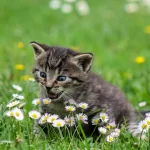
Feline lovers may note that there are uncommon cat coat colors, as well as spot patterns. Generally, there are some breeds of cats that have a little variety of colors in their fur. For example, the most common are white, orange, gray, or black, but there are other colors that attract attention because they are not seen as often, such as brown.
Seeing a brown cat (in its different shades) can be rare but not impossible. Next, we will tell you about the best brown cat breeds you should know about.
1. Havana Brown
This breed of cat was born in England from the mixture of brown siamese and chocolate Point which is why today, a beautiful coat can be seen as becoming one of the most sought-after cat breeds by breeders.
In addition, it is necessary to add that its name does not come from Cuba as we might think, but that it bears that name because of its dark brown fur, similar to coffee.

Characteristics
- Origin: Europe, UK.
- Physical features: Big ears and thin tail.
- Weight: 3 – 5 kg.
- Life expectancy: 10 – 15 years.
- Size/height: 25-30 cm male and female.
- Complexion: Medium and robust.
- Hair: Long.
- Weather: Temperate.
- Eyes color: diverse.
- Personality: It is a sweet companion who will ask you for your attention and affection every day. It is an active and very lively cat who likes to play and do new things.
- Health: It is a resistant breed although the diseases that most affect them are hypothermia, pulmonary or respiratory abnormalities, and endoparasites.
2. Burmese
The first Burmese cat appeared in France between 1916 and 1919 after a ship travels from a Buddhist temple, but it was not until 1966 that the Burmese cat was recognized as a breed in Great Britain.
Halfway between the Persians and Siamese, we find this curious feline that will captivate us, in addition to its exuberant appearance, due to its long fur and its captivating gaze, for its calm and docile character. Thus, we are a perfect breed for families, since they are very playful. Perhaps it is for all these charms that this breed is one of the most popular today.

Characteristics
- Origin: Asia.
- Physical features: Small ears, short sturdy legs, thick tail.
- Weight: 3 – 6 kg.
- Life expectancy: 10 – 15 years.
- Size/height: 23 – 28 cm male and 22 – 26 cm female.
- Complexion: Long, medium, and robust.
- Hair: Long.
- Weather: Temperate
- Eyes color: blue.
- Personality: These kittens have a very good character. They are very companions and like to play with other animals and children. It is a sociable breed so they are good at integrating into the family. They are very affectionate and are always looking for affection so they cannot stay alone for a long time so you should keep it in mind if you are a person who travels a lot or is away from home many hours.
- Health: They may suffer from glaucoma, cranial deformities, or feline hyperesthesia syndrome, a pathology that consists of an increase in sensitivity to touch or painful stimuli. They can also be prone to calcium oxalate stones in the urinary tract. Therefore, both the vaccination schedule and the periodic veterinary check-ups must be respected to prevent and detect these pathologies in time.
3. York Chocolate/Dark Brown
We could say that this breed was born by chance and not by the hand of man. The first litter of puppies of this breed was due to the mixture of a black house cat and another stray cat in New York. The owner of the cat was amazed by the color of the kittens and was given up for adoption until it became a breed and accepted by the CFF and ACFA in the 90s.

Characteristics
- Origin: America
- Physical features: Small ears.
- Weight: 4 – 8 kg.
- Life expectancy: 10 – 15 years (with good care, it can be more).
- Size/height: 30-35 cm male and 30 cm female.
- Complexion: Medium and robust.
- Hair: Long.
- Weather: It resists cold weather but not extreme temperatures.
- Eyes color: Green, blue, dark or light brown, yellow.
- Personality: He is very curious, funny, and intelligent. He is very friendly but can be a bit reserved with strangers. He has a fairly high energy level, so it is necessary to spend time with him so that he can burn it off and be calm.
- Health: May occur frequently the hypertrophic cardiomyopathy, i. e., an increase in the volume of the heart muscle. This pathology causes heart failure that can lead to arrhythmias or even lung edema or thrombosis of an artery. Tests to detect it are done by echocardiography and should be repeated at least once a year. Some treatments will improve its quality of life.
4. Devon Rex
The cats of this breed have different colors in their fur, among them brown in its different shades. Some may be brown with white, others are completely brown with some caramel-colored spots.
The devon rex arose in the 60s as a result of the crossing of a wild cat called Kirlee, who lived in a colony near a mine in the city of Devon, hence the name of the breed. They were called “devon rex” because, like rex rabbits and cornish rex, they have curly fur, which also makes them one of the considered hypoallergenic cats.

Characteristics
- Origin: Europe, UK.
- Physical features: Long thin tail, large ears, and eyes.
- Weight: 3 – 6 kg.
- Life expectancy: 10 – 15 years.
- Size/height: 25 – 30 cm male and female.
- Complexion: Small or medium.
- Hair: Short.
- Weather: Temperate.
- Eyes color: blue, green, yellow, hazelnut, copper, gold, or orange.
- Personality: These felines are extremely affectionate. They are fantastic cats in coexistence with children, other cats, or even dogs, as they are very sociable and flexible. They do not tolerate being alone for long.
- Health: This breed does not present characteristic diseases, however, they tend to suffer from ear infections such as otitis, therefore, they need frequent ear cleaning, otherwise they could suffer from a fever and develop a large infection.
5. Persian
The wide and flattened face and its abundant coat are two physical characteristics that distinguish this breed. It is said that they came to Europe from Iran (when it was still Persia) in 1620 but their exact origin is not yet known, although they come from the Turkish Angora. The breed was established in 1800 in England and is a highly chosen breed for its color varieties.

Characteristics
- Origin: Asia.
- Physical features: Small rounded ears, a prominent head, long thick tail, large eyes, and short legs.
- Weight: 3 – 5 kg.
- Life expectancy: 8 – 11 years.
- Size/height: 40 – 50 cm male and female.
- Complexion: Medium and robust.
- Hair: Long.
- Weather: Cold.
- Eyes color: Blue, green, coppery, hazelnut. They can also have heterochromatin.
- Personality: It is a calm and familiar cat. He gets along very well with other animals and with children (as long as they treat them well).
- Health: They can suffer kidney failure from 6 or 7 years old, so it is recommended to diagnose with an ultrasound so that it can have treatment or it can cause death. Also, they can suffer from herpes, pneumonia, respiratory problems, and heart problems. Pay attention if you notice that it is having trouble breathing or sneezing. Also, there is a gene in blue females that often cause abortions or has sick kittens; they must be cared for during pregnancy and after childbirth.
6. Oriental
The Oriental cat is a breed of cat from Thailand, the result of the cross between the Siamese cat, the Russian Blue, and the common shorthair. It can also be known as a Javanese or Mandarin cat.
Both the oriental shorthair cat and the oriental longhair cat are two variants of the same breed in the United States, but it is curious that in other parts of the world they are considered independent breeds.

Characteristics
- Origin: Europe, UK.
- Physical features: Triangular head, large ears with a broad base, prominent and always erect.
- Weight: 3 – 6 kg.
- Life expectancy: 12 – 15 years.
- Hair: Short and long.
- Weather: Temperate. They are sensitive to the cold.
- Eyes color: Almond-shaped eyes, oblique to the muzzle and deep blue or green. There are also specimens with heterochromia.
- Personality: Oriental cats are active, intelligent, ‘talkative’ and demand a lot of attention. They need a space where they can jump and climb. They like to spend time outdoors but they do not tolerate the cold even if they have long hair. It is a perfect breed for children and the elderly. They do not tolerate loneliness.
- Health: There are no notable pathologies in this breed except for strabismus. It is an inherited condition that alters the optic nerve but does not interfere with the quality of vision. However, it calls for veterinary monitoring to rule out complications that could reduce the animal’s visual acuity.
7. British Short Hair
This breed is quite old that it was born from the crossing of different breeds resulting in a strong but affectionate new breed. It is a highly sought-after breed and can be seen in many different colors, including brown.

Characteristics
- Origin: Europe, UK.
- Physical features: It is broad in the thorax, has short legs, and round feet.
- Weight: 3 – 7 kg.
- Life expectancy: 9 – 15 years.
- Size/height: 30 – 35 cm male and 28 – 30 cm female.
- Complexion: Muscular and robust body.
- Hair: Short.
- Weather: Good for the British cold Weather.
- Eyes color: Orange copper in general. In some cases gray or green.
- Personality: He is warm, affectionate, loyal, and adaptable. Calm but no less playful in character, the British Shorthair is the perfect pet for children and adults. It is not aggressive and gets along well with other cats and animals in general.
- Health: Some diseases that this breed usually suffers from are related to joint problems. They can also present hypertrophic cardiomyopathies, a genetic disease.
On the other hand, the British Shorthair can develop cysts in the kidney and some viral diseases, such as feline coronavirus and panleukopenia. Regular check-ups at the vet and following the recommended vaccination schedule are key to keeping this kitty healthy.
8. British Long Hair
The British longhair cat comes from the cross between British short hair and Persians after the world wars. Although at first, they did not want to create a new breed, over time they have been valued and today there are associations that have recognized them as a separate breed.

Characteristics
- Origin: Europe, UK.
- Physical features: Long thick tail. Large eyes and short legs.
- Weight: 4 – 8 kg.
- Life expectancy: 15 – 18 years.
- Size: 30 – 35 cm male and 28 – 30 cm female.
- Complexion: Medium and robust chest and shoulders.
- Hair: Long.
- Weather: Cold.
- Eyes color: Varied.
- Personality: They are characterized by presenting a calm, balanced, reserved, and independent personality. They are affectionate and playful cats. It is a cat that adapts very well to various types of homes, as well as children and other animals. However, he is somewhat shy and suspicious of strangers. It is not a breed that continually follows its caretakers asking for affection.
- Health: Long-haired British people seem to be more predisposed to certain diseases, such as being overweight, polycystic kidney disease, hypertrophic cardiomyopathy, and neonatal isoerythrolysis.
9. Siamese
This breed comes from Thailand and is a very ancient breed. It was marketed to different parts of Europe and America from 1880 but only in the 1950s did it become more popular among breeders.

Characteristics
- Origin: Asia, Thailand.
- Physical features: Due to a thermal gene, the coldest areas of the body (legs, tail, face, and ears) are darker than the trunk, which is usually a beige or cream color.
- Weight: 3 – 7 kg.
- Life expectancy: 12 – 18 years.
- Size: 30 – 35 cm male and female.
- Complexion: Long, Slim, Stylized.
- Hair/height: Short.
- Weather: Temperate.
- Eyes color: Blue
- Personality: This breed of cat has an outgoing and affectionate temperament by nature. He also tends to have a preference for one person if there are several who take care of him, following him everywhere, he can even learn to go on a leash on the street. He can live perfectly with other animals. They are very playful and active. They do not like loneliness.
- Health: They can develop respiratory diseases, and heart diseases, they can suffer from strabismus, poor circulation, obesity, otitis, and deafness complete the list of pathologies to which this breed is more prone. You should take it to the doctor from time to time, especially if you notice strange behavior.
10. Brown Himalayan
This breed can be confused with a long-haired Siamese due to its color, but why does it have so much hair? The truth is that it descends from the cross between a Siamese and a Persian, hence its long hair.

Characteristics
- Origin: Europe, Sweden.
- Physical features: Short and thick legs, big eyes, short tail.
- Weight: 5 – 8 kg.
- Life expectancy: 10 – 18 years.
- Size/height: 25 – 30 cm male and female.
- Complexion: Medium and Robust
- Hair: Long
- Weather: Cold
- Eyes color: Blue
- Personality: These cats are ideal to have at home as they get along very well with other animals and children. They are very sweet; they like to play although they can be lazy. You must play with them to keep them active.
- Health: The formation of hairballs can trigger choking and intestinal obstruction (you must brush it daily), ophthalmological alterations, and jaw and facial alterations. Polycystic in the kidney, and respiratory problems. To prevent this, it is recommended to go to the vet on a regular basis from 12 months of age to perform ultrasounds and thus keep possible alterations under control.
11. Chocolate Ragdoll
The ragdoll cat emerged in 1960 in California, United States, although the breed was not officially recognized until ten years later. The crossing was made using domestic cats such as the Siamese, Persian, and Burmese.
A peculiarity of the ragdoll consists in the fact that when it is taken on arms it is able to relax completely until it becomes inert like a doll. This characteristic is what precisely explains the origin of its name. Another characteristic is his voice, which is very weak, and he rarely meows, to the point that it is necessary to monitor him to make sure there is no problem.

Characteristics
- Origin: America, California.
- Physical features: Big eyes, short to medium legs, long tail. A wide head shape.
- Weight: 5 – 9 kg.
- Life expectancy: 8 – 15 years.
- Size/height: 30 – 45 cm male and 25 – 40 cm female.
- Complexion: Big and Robust.
- Hair: Long.
- Weather: Cold.
- Eyes color: Blue.
- Personality: If there is one feature that differentiates this breed, it is docility and devotion to its master. Ragdolls hate loneliness; they need to feel accompanied and sheltered at all times. If not, they become ill, and depressive which can kill them. Its genetic modifications have deprived this cat of any hunting, alert, or defense instincts. Reacts little to danger. It is an exclusively domestic and dependent cat so it should not roam outside on its own.
- Health: Hypertrophic cardiomyopathy stands out among the most prevalent pathologies of this breed, especially in older males. Its symptoms are shortness of breath, flaccidity of the hind limbs, loss of appetite, weight loss, or vomiting.
They can also suffer from urinary infections so you should pay attention to it as it’s painful for the cat. Also, they can have kidney failure producing weakness, lack of hunger, sadness, etc. They should receive immediate veterinary attention as all these can produce in death.
Also, it is very usual that they eat their own hair when cleaning themselves which will produce intestinal obstructions. Pay attention to the cat’s behavior and brush its hair daily. Talk with a veterinary doctor to help the cat to purge.
12. Brown Maine Coon
The Maine Coon cat, formerly known as the American Forest Cat, is not only one of the largest breeds of cats that exist domestically (it is within the Guinness records as the largest cat on the planet since 2024); It is also considered the oldest breed of cat in America.
However, the Maine Coon cat breed is perfect for family life. It loves company and pampering!

Characteristics
- Origin: America.
- Physical features: Thick and long tail, large ears and eyes, square head with prominent cheekbones.
- Weight: 5 – 10 kg.
- Life expectancy: 10 – 15 years.
- Size/height: 60 – 70 cm male and female.
- Complexion: Big and Robust.
- Hair: Long.
- Weather: Cold.
- Eyes color: Diverse.
- Personality: Enjoy being outdoors. Likes to play with water. It can take care of himself and his hunting instinct will do its best if you have a garden. It is calm, loving, and playful. They are not unfriendly cats with strangers and they enjoy the company of children or other pets. It is an especially docile cat and, well socialized, it does not usually present behavioral problems.
- Health: The most common diseases of the Maine coon are feline hypertrophic cardiomyopathy, hip dysplasia, and pectus excavatum. It is advisable to visit the vet every 6 to 12 months to perform a general examination and detect possible health problems.
13. Brown Japanese Bobtail
Although it tends to be confused with the American bobtail, the Japanese bobtail cat is a different breed whose only similarity is the short tail. The Japanese bobtail is one of the most appreciated cats in Asian culture since it is considered the cat of good luck.

Characteristics
- Origin: Asia, Japan.
- Physical features: Triangular head. Wide-based ears slightly inclined forward and always erect. Thin and long legs. Short tail.
- Weight: 3 – 5 kg.
- Life expectancy: 9 – 18 years.
- Size/height: 20 – 23 cm male and female.
- Complexion: Medium, slim and strong.
- Hair: It can be short, medium, or long.
- Weather: Temperate.
- Eyes color: Blue, green, copper, yellow. Etc.
- Personality: They are very playful and appreciate the company of people and other animals. They often take on a dominant role over dogs. They are very intelligent, they respond to their name and they will not hesitate to bring you their toys so that you can play with them. They do not tolerate loneliness.
- Health: Since human intervention did not take place in their creation, they are not known of their own congenital pathologies. In the case of long-haired felines, if they do not receive the brushing they demand, they can present the sequelae of trichobezoars, obstructing their digestive tract. They must have an annual medical check-up.
14. Brown American Bobtail
The American bobtail cat breed appeared spontaneously due to a dominant genetic mutation in Arizona in the late 1960s. It is in no way genetically related to the Japanese bobtail breed, although they physically resemble, nor is it the result of mixing with another breed short-tailed.

Characteristics
- Origin: America.
- Physical features: Short tail. Wide and rounded head. Ears broad at the base, of medium size.
- Weight: 3 – 8 kg.
- Life expectancy: 10 – 18 years.
- Size/height: 23 – 25 cm male and female.
- Complexion: Medium and athletic body.
- Hair: Medium and long.
- Weather: It tolerates cold.
- Eyes color: Diverse.
- Personality: Intelligent, and playful, it gets along very well with not-so-young children and other animals. As soon as it sees an opportunity, it tends to sneak out to explore the outdoors and try to hunt some prey, as it loves to be away from home. For this reason, it can be taught to go on a leash and take walks with it to satiate that instinct. Usually, they are not emotionally dependent.
- Health: It is a breed with a tendency to suffer from hip dysplasia, which causes the joints to become inflamed and progressively weak, which makes it a degenerative disease that usually leads to the development of osteoarthritis, discomfort, pain, lameness, and muscle atrophy of the extremities later. Also, problems derived from a shorter spine may appear, appearing conditions at the level of the spine, bladder, or intestine.
15. Brown Balinese
This breed was born from the cross of the Siamese with other long-haired breeds, such as the Turkish Angora, it has inherited the point pattern and those intense blue eyes that captivate us from the Siamese.

Characteristics
- Origin: America.
- Physical features: Elongated body and legs. Thick tail. Medium-sized, triangular and elongated head. Large pointed ears.
- Weight: 3 – 6 kg.
- Life expectancy: 8 – 15 years.
- Size/height: 15 – 17 cm male and female.
- Complexion: Slender, muscular, medium.
- Hair: Long.
- Weather: Cold.
- Eyes color: Intense blue.
- Personality: These kitties are very active, so they appreciate having access to the outside, as well as cat trees or gyms of different heights. They are affectionate, but not excessively. They get along well with children and other animals. We highlight its predisposition to “talk” and that is that the Balinese has a very elegant meow.
- Health: They usually present with strabismus, nystagmus, otitis, and gastroenteritis. Take them to a veterinarian doctor for their regular medical check-up.
16. Brown American Curl
The American Curl cat is a relatively young breed of cat since the first appeared in 1981. The main characteristic of the American Curl is its ears. These have an outward curvature at the tip and make them look like a rosebud.

Characteristics
- Origin: America.
- Physical features: They are born with stiff ears but then curl back. Rectangular body and round legs. Large eyes.
- Weight: 2 – 7 kg.
- Life expectancy: 13 – 18 years.
- Size/height: 40 – 50 cm in male, 40 – 45 female.
- Complexion: Medium, robust.
- Hair: Short, medium, or long.
- Weather: Cold.
- Eyes color: Green, blue, yellow.
- Personality: They are very affectionate, sociable, playful, active, and intelligent kittens. They adapt to everything, they function perfectly both in a small apartment and in a spacious home with a garden. They willingly tolerate coexistence with other animals and because of their happy and peaceful nature, they enjoy games with children. They do not like loneliness and need to play and climb.
- Health: The American Curl does not have any registered genetic defects. The health problem that the American Curl can suffer, a priori, is with the ears. With routine control, this problem is eliminated but they must be sanitized regularly, also, they must be brushed to avoid intestinal problems.
17. Chocolate Somali
This breed is genetically related to the Abyssinian. In fact, for a time it was called a ‘long-haired Abyssinian’. Apparently, the recessive gene for long hair was not shown until the second generation, these specimens being separated at first. Nowadays it is a chosen cat breed because of its elegance.

Characteristics
- Origin: America.
- Physical features: Large, wide, pointed ears. Long, thick, and pointed tail, similar to that of a fox. The tail has more hair than the rest of the body. Big eyes.
- Weight: 4 – 8 kg.
- Life expectancy: 10 – 15 years.
- Size/height: 20 – 25 cm male and female.
- Complexion: Medium, stylized, strong, and elegant.
- Hair: Medium or long.
- Weather: Temperate.
- Eyes color: Green, cooper, almonds.
- Personality: The Somali is a cheerful, mischievous, and very active cat. It is not an ideal breed for homes with limited space. It gets along well with children and is affectionate. It is independent and very intelligent. It will be the happiest cat in the world if you have a garden with trees. Otherwise, give him a cat tree.
- Health: They usually present night blindness from the age of 6. Chronic gingivitis is a very common oral problem in this breed, kidney dysfunctions, also acute anemia. They need to be checked as they can cause death.
18. Brown Abyssinian
The first Abyssinian cat arrived in England around 1868 from Ethiopia, then Abyssinia, and participated in an exhibition in which it became famous. There are other sources that claim that it is a descendant of the British Bunny, the native cat of the British Kingdom. It was not until the 20th century that the Abyssinian cat was cataloged as a proper breed.

Characteristics
- Origin: Ethiopia, Africa.
- Physical features: Thin and long tail and legs. Big and round ears, big eyes.
- Weight: 3 – 6 kg.
- Life expectancy: 9 – 15 years.
- Size/height: 20 – 26 cm male, 20 – 21 cm female.
- Complexion: Stylized, medium, robust.
- Hair: Short.
- Weather: Temperate.
- Eyes color: Green, cooper, almonds, gold.
- Personality: It is a curious and very a





